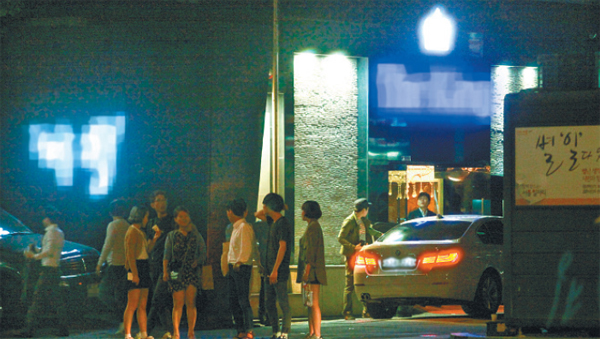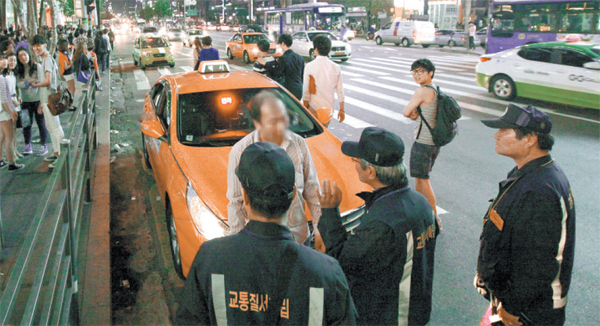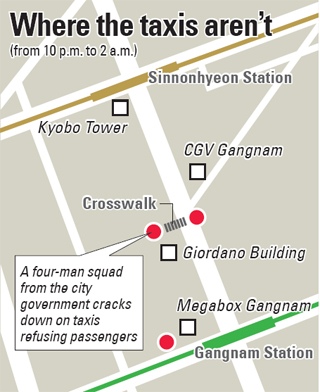A private solution to Gangnam’s late-night taxi war

A man gets in a private taxi, a BMW 5 Series sedan, in front of a room salon in Yeoksam-dong, southern Seoul, around 1 a.m. on May 24, a Friday night. By Park Sang-moon
The problem is getting a taxi in the wee hours of the morning in southern Seoul. Not many appear in the narrow alleys home to the watering holes of Gangnam, and competition is fierce among drinkers trying to find their way home. Many cabs demand extra payments or turn you down upon hearing the destination.
“I gotta go,” I say. But I don’t want the hassle of finding a cab. Just thinking about quarreling with a cab driver or some drunks puts me in a foul mood.
“I agree. We should get going,” my friend says. “My wife will kill me. I have to take my daughter to Everland [an amusement park] in the morning. I want to be in bed as soon as possible.”
“Good luck with that,” I say.
“Actually,” he replies, “I have a solution. I know how both of us can be home in 30 minutes.”
I know what kind of taxi jungle it is out there. I saw it on the way to the bar shortly after 1 a.m., when the subways are closed and buses slow to a crawl.

A taxi driver caught for refusing to take passengers argues with officials dispatched from the Seoul Metropolitan Government on Gangnam Boulevard around midnight on May 24, a Friday night. By Park Sang-moon
“How dare you want to be a part of the country’s public transportation system!” a woman in her 40s yells at a taxi that swings pass her, having heard where she wants to go. She is referring to the news of Taxi unions demanding a public transport status to qualify for government subsidies.
“The driver simply refused to take me. I think it’s because I live in Cheonho-dong [eastern Seoul].”
A few minutes later, a taxi pulls up with two men already in the back seat. Upon hearing her destination he nods, and only then she gets in the front seat. She will share the cab with others, which will probably add time to her journey.
The war for taxis in the area between Sinnonhyeon and Gangnam stations rages on every night, becoming more intense on weekends and holidays. The taxis have the upper hand so they can refuse passengers going in awkward directions - such as away from the drivers’ own homes - or charge exorbitant extra fees. Few want to go outside of Seoul, like Gyeonggi or Incheon.

Three teams of four, officials in their mid-50s, are dispatched daily from 10 p.m. to 2 a.m. to try and catch taxi drivers refusing passengers around Gangnam Boulevard.
It doesn’t do much good, as the government itself admits.
“When the clock ticks to midnight especially on weekends or the night before a holiday like today, there is not much we can do,” an official from the government told the Korea JoongAng Daily on the eve of Buddha’s Birthday.
But in some alleys of the Gangnam regions including Yeoksam, Sinsa and Apgujeong, there’s a way around drunken arguments with stubborn public cab drivers: Private cabs.
The karaoke bar that I am drinking in is in just such an alley close to exit 4 of Sinsa Station on subway line No. 3.
My friend calls the waiter. He asks him to check if his regular private taxi driver is available.
The waiter pulls out a walkie talkie. “Hey, checking on Uncle Jang.” He listens and turns to my friend. “He’s right outside, sir.”
When we went step outside we encounter four luxury imported sedans including a Lexus ES and Infiniti M.
“Sajangnim, I’m here!”
A man in his 40s wearing a black Adidas jacket waves and flicks away a cigarette. Sajangnim is an honorific title commonly used for the head of a company but adopted by bar workers for their customers. The driver opens a rear door. My friend and I clamber into his Mercedes-Benz S350.
My friend lives in Jukjeon, southern Gyeonggi, which generally takes about 45 minutes to an hour via regular taxi or express bus. My place is about 10 minutes away from his.
“It’s 100,000 won [$90] as always,” the driver says. “I will not charge your friend since he lives near your place.”
I realize it’s not a bad deal if we split the fare. The cabfare from Gangnam to my home in Yongin usually costs me 30,000 to 35,000 won late at night.
The backseat of the Mercedez is like a miniature convenience store, stocked with packs of wet wipes, cigarettes (Marlboro, Parliament and Dunhill) and bottles of Condition Heotgaesu, a nonalcoholic drink made with stalks of the oriental raisin tree and kudzu root whose alleged benefits include alleviating symptoms of hangover. Some sports newspapers and magazines are provided as well with an iPad loaded with games like Iron Man 3. Everything’s complimentary.
“What are these for?” I say, plucking a pair of brown pantyhose nestled in the basket with the cigarettes.
“Those are for the girls who work in karaoke joints or hostess bars,” the driver laughs. “They often take taxis like these when they go to the beauty shop in the afternoon or home after work. Private taxis are a really good option for them so they don’t have to be in public space for long, especially when they’re all dressed up for work and wearing heavy makeup. We pick them up right outside their apartment buildings.” Private luxury taxis have existed for a long time, especially for girls and goons who work the hostess bars and karaoke shops. They don’t travel far, so the more than doubled fares aren’t much of a factor. And some private taxis use local luxury sedan models like the Hyundai Grandeur or Kia Opirus and don’t charge as much.
“The business has upgraded itself to attract more passengers,” the driver says. “As luxury imports stopped being the exclusive privilege of the rich, people in the adult entertainment business who makes money easily and spend money just as readily looked for more convenient services in a fancy style. And we cater those services to them.”
In fact, the police have been trying to root out illegal taxis because they’re not registered, can’t be controlled and are often driven by people with criminal records. And passengers can’t get insurance benefits in case an accident occurs. The crackdowns are regular - and regularly avoided. Once they stop, the taxis are back in the alleys and back on the boulevards.
In mid-April, the Seoul Metropolitan Police Agency arrested five owners of illegal private taxi companies including one run by a man surnamed Park, 42, and booked its 59 drivers.
According to the police, that racket earned about 2.3 billion won from October 2010 to last April, and their loyal customers were celebrities in the entertainment industy, hostesses in karaoke and hostess bars and some students in the Gangnam area who study very late at hagwon, or cram schools. The police later discovered that about 75 percent of the drivers were ex-convicts with records of robbery or rape.
In January, a 29-year-old Korean-Chinese driver surnamed Lim was arrested for raping a hostess from a bar in Gangnam at her studio apartment. Lim allegedly drove the victim, who was passed out drunk, to her home and raped her, according to the Seoul Central District Prosecutors’ Office.
“We can only estimate that there are hundreds of private taxis,” a spokesman for the Woman and Juvenile Crime division of the Gangnam Police Precinct said. “We have been trying to crack down on these violations by cooperating with local district offices but the problem is always the manpower shortage.”
The fare for passengers traveling within the Gangnam region - Gangnam, Seocho and Songpa districts - is 10,000 won, and the fare increases 30,000 won to 50,000 won if they travel to other Seoul areas like northern Seoul or western Seoul. Other metropolitan areas - Gyeonggi and Incheon - are charged 100,000 won and higher.
In less than five minutes, our car approaches the ramp leading to the Gyeongbu Expressway after disregarding some stoplights and cutting off some other cars. As soon as it squeezes onto the expressway, the S350 starts showing off its 3,500 cc V6 engine, which has 306 maximum horsepower.
In seconds, the car’s gauge shows that it is running at 150 kilometers (94 miles) per hour.
I realize how deeply grateful I am that my Buddhist mother prays for my health and safety all the time.
Around 3 a.m., the taxi arrives at an apartment complex in Jukjeon and drops off my friend. It took about 22 minutes to travel from Gangnam to Jukjeon, which is about 24 kilometers (15 miles).
“As long as those girls or customers like you exist,” the driver tells me, “this business will survive no matter how much we charge.”
By Kwon Sang-soo [sakwon80@joongang.co.kr]










with the Korea JoongAng Daily
To write comments, please log in to one of the accounts.
Standards Board Policy (0/250자)